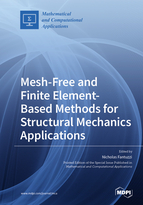Mesh-Free and Finite Element-Based Methods for Structural Mechanics Applications
A special issue of Mathematical and Computational Applications (ISSN 2297-8747). This special issue belongs to the section "Engineering".
Deadline for manuscript submissions: closed (15 February 2020) | Viewed by 35960
Special Issue Editor
Interests: modeling of offshore structures and offshore structural components; structural theories of plates and applied mathematical modeling; mechanics of solids and structures; study of composite laminated structures and advanced composite materials; fracture mechanics and crack propagation and initiation; applied numerical methods such as finite element method and mesh-free element method
Special Issues, Collections and Topics in MDPI journals
Special Issue Information
Dear Colleagues,
The problem of solving complex engineering problems has been always a major topic in all industrial fields, such as aerospace, civil and mechanical engineering. The use of numerical methods increased exponentially in the last few years due to modern computers in the field of structural mechanics.
Moreover, a wide-range of numerical methods has been presented in the literature for solving such problems. Structural mechanics problems are dealt with using partial differential systems of equations that might be solved by following the two main classes of methods: Domain-decomposition methods or the so-called finite element methods and mesh-free methods where no decomposition is carried out. Both methodologies discretize a partial differential system into a set of algebraic equations that can be easily solved by computer implementation. The aim of the present Special Issue is to present a collection of recent works on these themes and a comparison of the novel advancements of both worlds in structural mechanics applications.
Assist. Prof. Dr. Nicholas Fantuzzi
Guest Editor
Manuscript Submission Information
Manuscripts should be submitted online at www.mdpi.com by registering and logging in to this website. Once you are registered, click here to go to the submission form. Manuscripts can be submitted until the deadline. All submissions that pass pre-check are peer-reviewed. Accepted papers will be published continuously in the journal (as soon as accepted) and will be listed together on the special issue website. Research articles, review articles as well as short communications are invited. For planned papers, a title and short abstract (about 100 words) can be sent to the Editorial Office for announcement on this website.
Submitted manuscripts should not have been published previously, nor be under consideration for publication elsewhere (except conference proceedings papers). All manuscripts are thoroughly refereed through a single-blind peer-review process. A guide for authors and other relevant information for submission of manuscripts is available on the Instructions for Authors page. Mathematical and Computational Applications is an international peer-reviewed open access semimonthly journal published by MDPI.
Please visit the Instructions for Authors page before submitting a manuscript. The Article Processing Charge (APC) for publication in this open access journal is 1400 CHF (Swiss Francs). Submitted papers should be well formatted and use good English. Authors may use MDPI's English editing service prior to publication or during author revisions.






